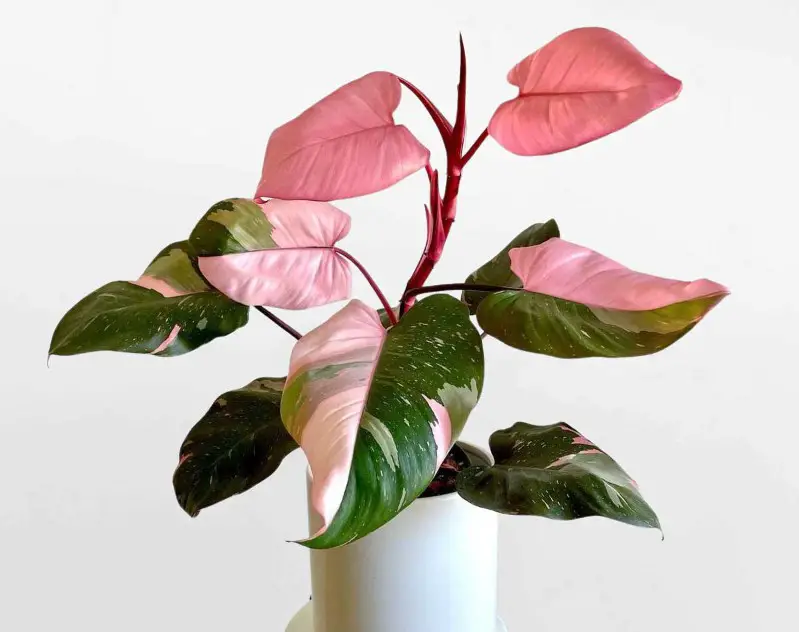The Pink Princess Philodendron (Philodendron erubescens ‘Pink Princess’) has taken the plant world by storm, becoming a prized possession for plant enthusiasts and collectors alike. Known for its striking bubblegum pink variegation set against deep green, heart-shaped leaves, this tropical beauty not only serves as a stunning decorative piece but also brings joy and a sense of accomplishment when nurtured properly.
In this comprehensive guide, we will delve into the intricacies of caring for the Pink Princess Philodendron and provide expert tips for ensuring it flourishes in your home.
Understanding the Pink Princess Philodendron
What Makes the Pink Princess Unique?

The Pink Princess Philodendron is a member of the Araceae family and is native to the tropical rainforests of Colombia. Its stable variegation, which is a result of natural genetic mutations, distinguishes it from similar plants like the Philodendron Pink Congo, whose color is chemically induced and often fades back to green. This natural variance gives the Pink Princess its appeal, as it showcases a unique blend of colors in every leaf.
Key Characteristics
- Botanical Name: Philodendron erubescens ‘Pink Princess’
- Common Names: Pink Princess Philodendron, Blushing Philodendron
- Family: Araceae
- Mature Size: 4-5 feet tall and 2-4 feet wide
- Sun Exposure: Prefers partial sunlight
- Soil Type: Loamy, moist, but well-draining
- Bloom Time: Primarily in spring and summer
- Flower Color: Green and white
- Hardiness Zones: 9a, 9b, 10a, 10b, 11a, 11b
Essential Care Tips for Your Pink Princess Philodendron
Optimal Light Conditions
Understanding Light Requirements
The first and foremost factor influencing the health and appearance of your Pink Princess Philodendron is its light exposure. Providing adequate light is crucial for maintaining the vibrant pink hues of its leaves. Ideally, place your plant in an area where it receives several hours of bright, indirect sunlight each day.
Tips for Managing Light Levels
- Indirect Sunlight: Aim for bright but indirect light; direct sun can scorch the delicate pink areas.
- Grow Lights: If natural light is insufficient, consider investing in grow lights designed for indoor plants to supplement their light needs.
- Signs of Insufficient Light: Watch for leaves turning completely green or the plant becoming leggy, which indicates it’s stretching towards a light source.
Soil Selection: The Right Mix for Success
Ideal Soil Composition
The Pink Princess Philodendron thrives in well-draining, airy soil that retains some moisture while preventing root rot. An ideal soil mix consists of:
- One part standard potting soil
- One part perlite
- One part orchid bark
This mixture allows for proper drainage and airflow to the roots, mimicking the plant’s natural tropical habitat.
Watering Guidelines: Balancing Moisture
How to Water Effectively
Overwatering is a common pitfall for many plant owners, especially for the Pink Princess Philodendron. To maintain its health:
- Check Soil Moisture: Allow the top 2 inches of soil to dry out between waterings. Use your finger to test; if it feels dry, it’s time to water.
- Watering Frequency: Typically, water once a week during spring and summer, and every 1-2 weeks in the fall and winter months when growth slows down.
- Avoid Waterlogging: Ensure the pot has drainage holes to prevent water from sitting at the bottom, which can lead to root rot.
Temperature and Humidity: Creating the Ideal Environment
Best Conditions for Growth
The Pink Princess Philodendron is a tropical plant that thrives in warm and humid conditions:
- Ideal Temperature Range: Keep the temperature between 65°F to 79°F (18°C to 26°C).
- Humidity Levels: This plant prefers humidity levels of around 50% to 60%.
Tips to Increase Humidity
- Humidity Trays: Place a shallow tray filled with water and pebbles beneath the pot to increase humidity around the plant.
- Grouping Plants: Surround your Pink Princess with other plants to create a microenvironment with higher humidity levels.
- Misting: Lightly mist the leaves with water occasionally, especially during dry winter months, but be cautious not to overdo it to avoid fungal issues.
Fertilization Strategies for Vibrant Growth
Feeding Your Pink Princess
During the growing season (spring and summer), your Pink Princess Philodendron benefits from regular feeding:
- Fertilizing Schedule: Use a balanced liquid fertilizer once a month. Stop fertilizing in early fall when the plant enters its dormant phase.
- Signs of Over-Fertilization: Watch for browning leaf tips or excessive leaf drop, which could indicate nutrient burn.
Repotting Your Pink Princess: When and How
Identifying the Right Time to Repot
As your Pink Princess grows, it will eventually outgrow its pot. Signs that it’s time to repot include:
- Roots Emerging from Drainage Holes: This indicates the plant needs more space.
- Circling Roots: If you notice roots growing around the inside of the pot, it’s time to give your plant a new home.
Steps for Successful Repotting
- Choose a Larger Pot: Select a pot that is 2-4 inches larger in diameter than the current one, ensuring it has drainage holes.
- Prepare Fresh Soil: Use the same well-draining mix as mentioned above.
- Remove the Plant: Gently take the Pink Princess out of its pot, loosening the root ball carefully.
- Position in New Pot: Place the plant in the new pot and fill with fresh soil, ensuring the roots are covered.
- Water Thoroughly: After repotting, give the plant a good watering and allow excess water to drain.
Propagation: Expanding Your Collection
Simple Steps for Stem Cutting Propagation
Propagating your Pink Princess Philodendron is an excellent way to grow your collection or share with friends:
- Select a Healthy Stem: Choose a stem with 2-3 leaves and at least 2 nodes.
- Cut the Stem: Use sterilized scissors to make a clean cut below a node.
- Prepare the Cutting: Remove the lower leaves and let the cutting callous for 12-24 hours.
- Rooting in Water: Place the cutting in water, ensuring nodes are submerged. Keep it in bright, indirect light.
- Transplanting: Once roots are at least 1 inch long, transfer to soil and water thoroughly.
Common Pests and Diseases: Keeping Your Plant Healthy
Pests to Watch For
The Pink Princess Philodendron can attract various pests, including:
- Mealybugs
- Spider mites
- Aphids
- Scale
Disease Prevention
Root Rot is a serious concern often caused by overwatering. To prevent it:
- Ensure Proper Drainage: Always use a pot with drainage holes and a well-draining soil mix.
- Monitor Watering Practices: Adjust watering frequency based on the plant’s environment and seasons.
Troubleshooting Common Issues
Leaves Losing Variegation
If the leaves begin to lose their pink variegation, it could be due to insufficient light. Ensure your plant receives enough bright, indirect light to encourage vibrant colors.
Leggy Growth
A leggy appearance indicates that your plant is stretching toward light. Move it to a brighter location to help it grow fuller and denser.
Brown Leaf Edges
Brown edges can signal low humidity levels. Increase humidity around the plant to prevent further damage.
Where to Buy a Pink Princess Philodendron
Due to its popularity, acquiring a Pink Princess Philodendron can be challenging, and prices can vary significantly. When purchasing:
- Research Reputable Sellers: Look for established nurseries or trusted online retailers that specialize in houseplants.
- Check for Healthy Specimens: Ensure the plant has vibrant leaves without signs of pests or diseases.
Conclusion
Caring for a Pink Princess Philodendron can be incredibly rewarding when done correctly. With the right light, soil, watering, and humidity conditions, you can enjoy the stunning beauty of this unique plant for years to come. Whether you’re a seasoned plant owner or new to houseplants, following these comprehensive care tips will help you nurture your Pink Princess into a thriving, vibrant centerpiece in your home. By understanding the needs of your plant and providing optimal care, you can ensure that its gorgeous pink variegation remains a striking feature in your plant collection.






